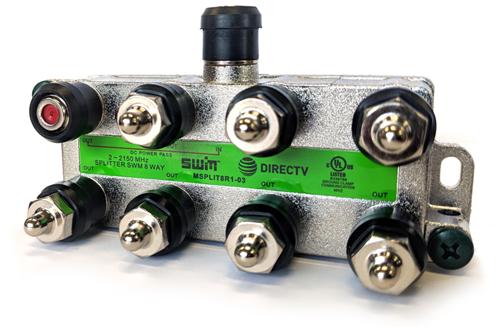So, this happened. It was a few weeks ago. A client calls and says that they are having satellite problems. They are pretty sure, they say, the cable is in backwards. Now, that’s impossible. Cables don’t have a front and a back way, so it’s not like that really makes a difference. The funny thing though, was that this customer was right and they just weren’t expressing themselves properly. Our tech sat with them and with the help of some video chat, we were able to figure out what was really going on.
When you look at a typical DIRECTV splitter:

You can see that there is a top connection and 8 connections on the front. This customer had connected the line to the dish to one of the front connections and the receiver to the top connection. This didn’t work because the dish wasn’t getting any power.
If you think about it, the customer was describing the exact problem they were having. It took a little imagination to see it, but once we did, we helped them fix things quickly and they were back to watching great satellite television.
The funny thing is this isn’t always a problem.
There are cases, actually, when you can use a splitter backwards, in the case of antenna or cable TV signals. In that case it’s referred to as a “combiner” because it combines the signals from all the inputs into a single cable, or a “diplexer” if it’s smart enough to isolate out specific signals from specific inputs. This is common in some commercial situations, but it’s never used in home satellite TV.
Satellite TV splitters like the one you see above have special things built into them. Because they pass power on only one port, they’re engineered differently. Because they also pass internet information as well as satellite TV, they make for particularly bad splitters for any other purpose. But, for satellite TV, which is what they’re designed for, they’re perfect. If you need a DIRECTV splitter, check out our selection. These are the same exact parts that DIRECTV’s own technicians have in their trucks. They’re going to work for you.
What’s the lesson to be learned?
The lesson here was actually to listen carefully to every customer. The customer was actually right, although he didn’t really explain himself well. At Solid Signal we take our customers seriously. Our customers are our eyes and ears and by listening actively, our techs can usually solve a problem. We’re very proud of the way our 100% US-based call centers help hundreds of people every day with their questions. Are you one of them? If you’ve never called Solid Signal, give it a try the next time you need something! Unlike some other (very big) retailers, we make it easy for you to call and get the help you need. It all starts with… 888-233-7563.
And of course, shop at Solid Signal whenever you want the same parts the professionals use. We have the best selection, the best prices, and the best service!





